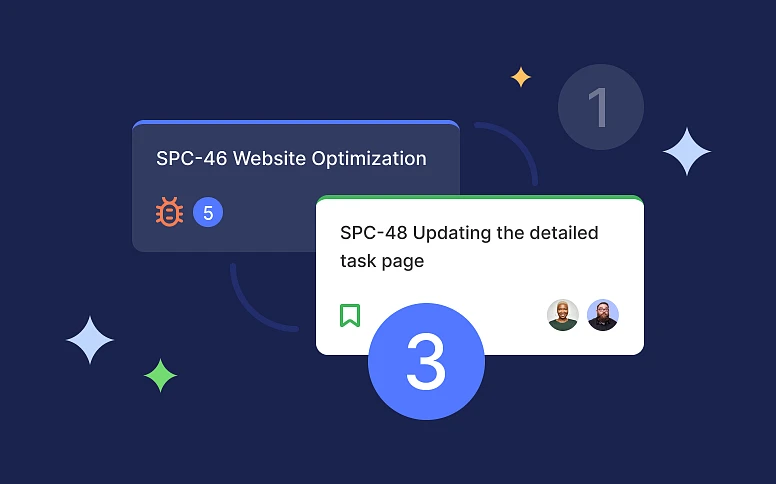What are Agile Estimations?
For more flexible projects without strict deadlines, Agile estimation is a must-have method to evaluate activities. Today, we’ll learn a little bit more about the most common Agile estimating methods and find better ways to use them.
What is Agile Methodology and Its Estimations
Originally, the Agile methodology came from software development. Anyway, nowadays, Agile is a popular framework to manage projects across different industries, not just software development. The key point is that the project should be flexible, without strict deadlines and requirements to use Agile.
How does Agile differ from other PM methodologies?
- Projects, based on Agile, split the whole workflow into iterations.
- Stakeholders and product owners are included in the decision-making process. Usually, they have meetings with the project team after each iteration.
- Agile doesn’t suit projects with strict deadlines and predefined goals.
- Requires regular improvements and changes.
Speaking of estimations from more strict methodologies, such as waterfall, they’re more like predictions, while Agile estimates are more like a plan. Traditional PM methodologies imply defined budgets and timeframes, so they don’t encourage changes. Agile, as it was mentioned before, are more flexible, so they appear as a guide rather than frames. To put it simply, Agile estimations outline main activities and helps you stay on the right track, but they can and have to change.
What is Agile Estimation and Why Do You Need It?
All Agile projects have a backlog. Backlog is a list of to-do tasks, and all of them are prioritized. These tasks you take to the sprint. Tasks with the highest priority you take to the sprint first while other tasks are patiently waiting for their turn to be added to the next sprint. In that case, estimations help to prioritize tasks, define more critical ones, and pay them extra attention. Without estimations, you could pick any task without thinking if it is the right time to do that.
Based upon the information above, we can conclude that Agile estimations are a tool to prioritize activities during all the projects. Estimations help focus on things that are really important and complete huge tasks first rather than completing unnecessaries.
You might think that the task estimation process is unnecessary red tape, but in fact, it is worth taking some time. Speaking of the origins of Agile estimations, they were created to help you link one task to the next, define priorities, and identify dependencies.
How does Agile Estimation Benefit Your Project?
It requires some time to implement Agile estimating into the workflow, especially if it’s your first time working with flexible methodologies. But once they’re implemented, estimations can bring lots of benefits to the project management process.
Outline Possible Risks
Agile estimating helps find possible concerns and stumbling rocks. For example, with Agile estimations, you can predict that an employee will possibly be out of deadlines. Once you know when the delays are possible, you can easily prevent them or just be prepared and warn your stakeholders.
Communication Enhancement
Initial estimation helps predict the quantity of future activities and possible timelines. When you know how much work is approaching, it’s easier to build communication with the team even before starting the project. You can assign each teammate to the task, populate sprints, and ensure transparency so everyone on the team understands what they’ll have to do.
Improved time management
As it was mentioned, Agile estimates imply dependencies on the workflow, so you can prioritize activities better and understand what has to be done urgently. The main point is that you can start planning ahead and then change your project according to stakeholder feedback or market changes.
Simply put, Agile estimation mostly affects timelines and team collaboration. Moreover, in most cases, agile estimation is used to replace dates and deadlines. It means that the team can focus on difficulty and quality of work, rather than focusing on timeframes. First of all, it improves the final output and helps quickly implement changes to the project.
4 Examples of Agile Estimation
There are lots of different varieties of Agile estimations. In general, they all cover the complicity of the work. Anyway, each estimation is more appropriate for a particular team or project.
Today, we’ll show you some of the most popular techniques used by Scrum teams:
Poker Planning
Poker planning is probably the most popular way to estimate in Agile. In poker planning, each person included in the process has a strict number of numbered cards. Each task has to be discussed and estimated based on previous experience. For example, if you know the approximate effort that has to be taken to complete the task, you can give it a fair estimation. Each member of the team chooses a card (the team has to reveal cards simultaneously). The final value of the task is based on the prevailing number on the cards.
T-Shirt Size
T-shirt sizing is a simple method based on the regular shirt sizes: XS, S, M, L, XL, and XXL. The larger the size is – the more complex the task is. But before starting the estimating process, your team should decide how complex each size is.
The Bucket Estimation
The bucket estimate is a must-have method when you need to evaluate a large amount of work. You can use as many buckets as you need, but in most cases, there are three of them: small, medium, and large. Each bucket has its own estimation, mostly a range of story points. All you need to do is just give your teammates cards with tasks on it and they simply throw these cards into buckets according to the estimation they’d give to this task.
Relative Sizing
In the relative sizing approach, you split similar or equivalent items within categories. Then, you’re just comparing tasks of different sizes. When you’re comparing different tasks, it’s much easier to understand if the task is larger or smaller, or even more complex.
In some Agile estimations, such as t-shirt sizing or poker planning, there are Fibonacci sequences.
Fibonacci sequences are a range of numbers created by combining two previous sequences together. For example: 0, 1, 2, 3, 5, 8, 13, etc.
Fibonacci sequences help to get rid of hangups when it comes to small differences. These sequences are frequently used in large projects, which are hard to estimate.
Common Struggles of Agile Estimations
While building proper estimations, there are some common pitfalls that you should consider.
First of all, you should always keep in mind that Agile estimations are not a target to hit. Estimation is just a guide for your team to follow the main path. Estimates can change over time, but they’re still an important part of long-term planning. Moreover, they have to change from time to time because they require regular revisions. Some tasks can become more complex than they were at the beginning of a project, so estimations can turn out to be unfair.
Not involving your teammates and external stakeholders is also a mistake while estimating Agile projects. Stakeholders play an important role in flexible methodologies, including Agile. Your output should be based on regular communication with the team, users, customers, and experts as well. It means that a fair estimation should be based on the opinions and experiences of all the stakeholders, both internal and external.
To sum up, Agile estimating process can face the following challenges:
- Stagnation and lack of revisions
- Inflexible mindset.
- not involving stakeholders in the estimation process.
In Summary
At first sight, Agile estimations can look like red tape. But once you start planning your project with Agile estimations, it’s obvious how it can benefit the whole workflow. A proper estimation can help you understand the size of a project, possible challenges, and approximate timelines.
Working according to Agile means to be a team player and always follow the changes to bring the most benefits to stakeholders. Estimates, as part of the process, are a powerful tool to boost the final result of a project.
It’s a complex process, so each member of the team has to participate. Keep everyone involved helps to make a fair estimation, without overrating or underrating activities.
In general, Agile estimations don’t relate to hours. But in fact, you can collocate them. In that case, 1 story point will take about 2 hours.
T-shirt sizing, Poker planning and Relative sizing.
The gap between sequences helps better understand how one task differs from another, which leads to fair estimating.











